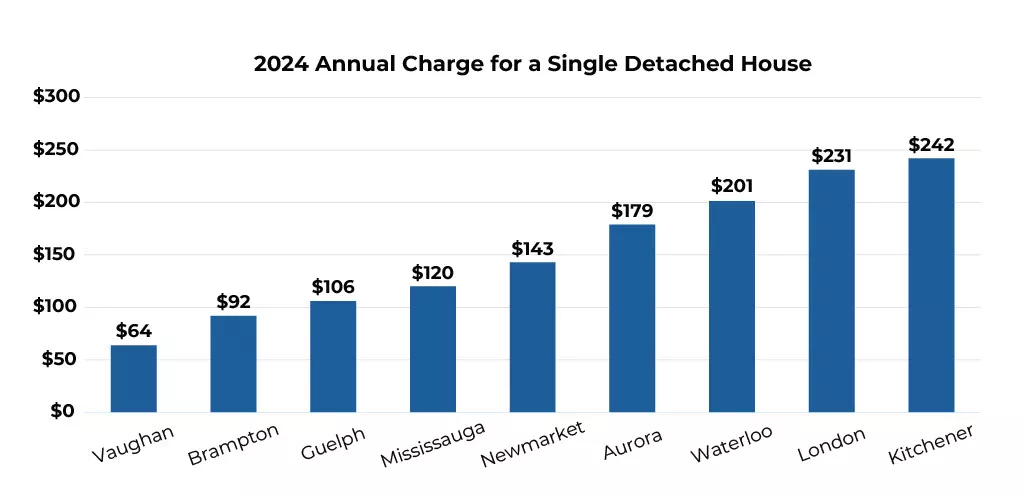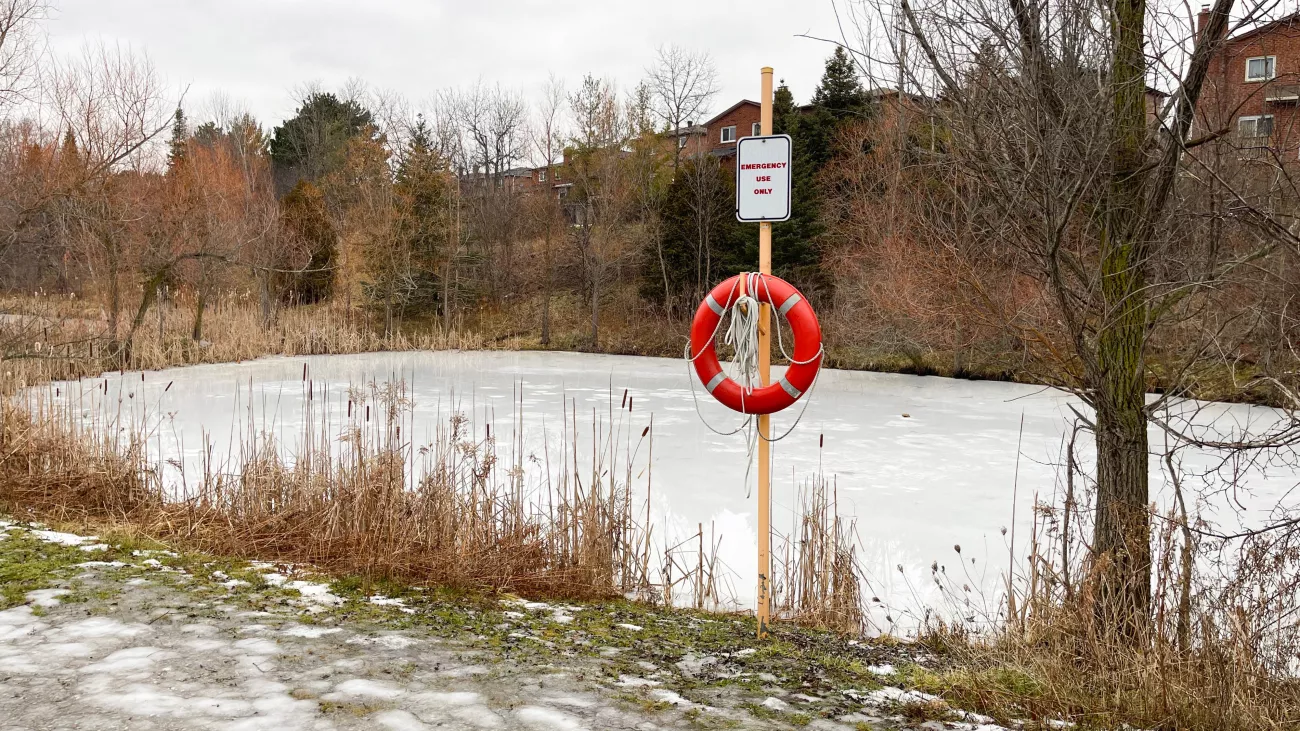Stormwater Rate Study
The City of Vaughan is reviewing the current rate structure to ensure it’s fair, equitable and financially sustainable for residents, businesses and property owners while achieving the funding necessary to provide reliable stormwater services as Vaughan continues to grow. This will help ensure that the City’s stormwater management system can continue to protect people, property, the environment and water resources both now and in the future.
About Stormwater Management
Stormwater is rainwater and melted snow that runs off roofs, driveways, parking lots and other hard surfaces. Hard surfaces prevent stormwater from naturally soaking into the ground. Instead, stormwater builds up on the surface and flows into the City’s stormwater management system and then drains into our rivers and streams. Unmanaged stormwater can lead to flooding, river erosion and can carry pollutants and litter into the environment – damaging both the built and natural environment.
Stormwater management involves controlling the quantity and quality of stormwater runoff resulting from rainfall and snowmelt. The City maintains a complex network of stormwater management assets and services to mitigate potential issues caused by excess stormwater runoff, including underground stormwater pipe networks, ditches, culverts, stormwater management ponds and much more. Learn more about stormwater.
Study Overview and Timeline
The Stormwater Rate Study will:
- assess the current and required costs involved in delivering stormwater services across the city.
- analyze and evaluate alternative ways to fund stormwater management using key criteria.
- gather community input through an online survey, pop-up events and a virtual meeting.
- recommend a preferred stormwater rate and rate structure based on a technical evaluation and consideration of public input.
The study is anticipated to be completed in 2025. The findings of the study will then be presented at a future Committee of the Whole meeting for Council consideration.
Past Public Engagement Events
- Pop-up events: The study team hosted five pop-up events to meet with residents in person:
- Sunday, Jan. 19 at Maple Community Centre (10190 Keele St.)
- Monday, Jan. 20 at Vellore Village Community Centre (1 Villa Royale Ave.)
- Wednesday, Jan. 22 at Al Palladini Community Centre (9201 Islington Ave.)
- Thursday, Jan. 23 at Garnet Williams Community Centre (501 Clark Ave. W.)
- Sunday, Jan. 26 at North Thornhill Community Centre (300 Pleasant Ridge Ave.)
Review the material (PDF) shared at the pop-up events.
- Virtual meeting: The study team hosted a virtual meeting on Thursday, Jan. 30. View the presentation slides (PDF) and the meeting recording.
- Online survey: An online survey was available until Feb. 14. Thank you to everyone who participated.
About the Stormwater Rate
The stormwater rate is billed once annually. The collected funds are held in the City’s stormwater funding reserve and are used exclusively to deliver stormwater services, operational programming and capital infrastructure projects like the Black Creek Channel Renewal and Edgeley Pond Construction.
The City’s stormwater funding reserve is currently experiencing significant pressure. As the city continues to grow, so do pressures on our stormwater system. Additionally, significant weather events like heavy rain and snow can put a strain on our stormwater system. As we experience more frequent and intense weather events, we can expect that the impacts and demand on our stormwater infrastructure will also intensify.
The Current Stormwater Rate Structure
The current stormwater rate structure divides properties into seven tiers. The seven tiers are:
- small non-residential
- medium non-residential
- large non-residential
- agricultural/vacant
- low-density residential
- medium-density residential
- high-density residential
Each property tier is then charged based on the estimated stormwater runoff for their tier.
Comparison with Other Municipalities
Currently, the City charges its residents less for stormwater management than various other comparable municipalities. In 2024, the average single-family detached home in Vaughan paid $64.20 for their annual stormwater charge.

Provincial Regulations
Ontario Regulation 588/17: Asset Management Planning for Municipal Infrastructure requires all municipalities to have Asset Management Plans that include information about: the levels of service that they propose to provide, the activities required to meet those levels of service and a strategy to fund those activities. This legislation requires the City to have a clear, financially sound plan to pay for core services like stormwater management.
Frequently Asked Questions
-
Answer
Stormwater is rainwater and melted snow that runs off buildings, driveways and other land surfaces. Under natural conditions, most runoff is either soaked up by plants and trees, absorbed into the ground or drains into ponds and creeks. Hard surfaces, such as parking lots, driveways and rooftops, prevent stormwater from naturally soaking into the ground or being absorbed by plants. Instead, stormwater builds up on the surface and flows into the City’s stormwater management system and then drains into our creeks, rivers and lakes.
-
Answer
Stormwater has several environmental and property impacts. Excess stormwater runoff that does not soak into the ground can pick up pollutants such as oil, pesticides, bacteria and trash before flowing into storm drains, drainage ditches and creeks. This water is not cleaned at a treatment plant before it flows into our creeks, rivers and lakes, which are sources of our drinking water. Runoff can also cause higher and faster water flow during storms, which can lead to flooding, erode creeks and rivers and bring waste and debris into the city’s waterbodies. This can negatively impact water quality and result in the reduction and loss of aquatic life and biodiversity.
-
Answer
Stormwater management involves controlling the quantity and quality of runoff that results from rainfall and snowmelt, addressing issues such as flooding, erosion and poor water quality. The City has more than 1,000 kilometres of stormwater pipes, more than 22,000 catch basins and more than 150 stormwater management ponds that help to protect the environment and prevent flooding.
-
Answer
The City is conducting a Stormwater Rate Study to review the current rate structure to ensure it’s fair, equitable and financially sustainable for residents, businesses and property owners while achieving the necessary funding to provide reliable stormwater services as Vaughan continues to grow. Critical operating and infrastructure investments in this system are funded through the annual stormwater charge. The findings of the study will inform the funding model to ensure our stormwater system is properly financed, future-ready and can continue to safeguard the community, environment, property and water resources.
-
Answer
The City’s stormwater charge is a tiered runoff-based stormwater fee that categorizes properties into seven tiers:
- small non-residential
- medium non-residential
- large non-residential
- agricultural/vacant
- low-density residential
- medium-density residential
- high-density residential
Each property tier is then charged based on their tier’s estimated stormwater runoff contribution.
-
Answer
The 2024 stormwater charges are provided below in accordance with By-law 224-2023 (PDF):
Property Type Criteria 2024 Stormwater Charge
(one-time annual fee)Non-residential (small) Less than 1 acre $58.21 Non-residential (medium) 1 to 10 acres $1,504.16 Non-residential (large) More than 10 acres $22,973.14 Agricultural/vacant $806.77 Residential (low-density) Typically single detached homes $64.20 Residential (medium-density) Typically townhouses $41.20 Residential (high-density) Typically condominiums $253.62
The charges are reviewed annually. -
Answer
The Stormwater Rate Study will explore, analyze and evaluate modifications to the current rate structure and alternative rate structures. When developing various structures, different factors will be considered, including:
- Total surface area: the total area of a property, encompassing all land within its boundaries, including both pervious (soft) surfaces (e.g. lawns, gardens) and impervious (hard) surfaces (e.g. rooftops, driveways). The surface area is a critical factor in stormwater management, as it influences the volume of runoff generated during precipitation events.
- Impervious (hard) area: the portions of a property covered by materials that significantly impede water absorption into the soil. Examples include parking lots, driveways, rooftops and compacted gravel surfaces. Impervious areas prevent rainwater from naturally soaking into the ground, which can increase surface runoff.
- Property type: appropriately grouping properties based on typical uses, common characteristics and anticipated stormwater impacts. For example, residential properties typically feature gardens and lawns, while commercial properties have larger buildings and parking lots. Property type is the primary consideration in the City’s current tiered rate structure.
-
Answer
The new options will be evaluated using the suggested following guiding principles:
- Comparability to industry benchmarks, including the rates and rate structures of similar municipalities.
- Fairness and equity, including the degree to which the identified rate structure accurately reflects stormwater costs and impacts on the City’s infrastructure.
- Financial sustainability, including whether the identified rate structure will adequately and reliably meet Vaughan’s current and future stormwater funding requirements
- Citizen affordability, including assessing the financial impact on the average resident and property owners in Vaughan.
- Environmental benefits, including whether the identified structure may reduce negative environmental impacts and promote better stormwater practices.
-
Answer
A rate structure will be recommended based on the findings of a technical evaluation as well as consideration of feedback from the public. The findings of the study will be presented at a future Committee of the Whole meeting for Council consideration.

